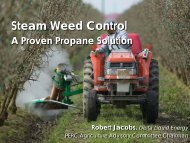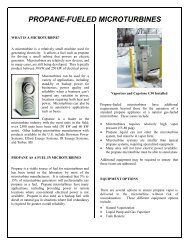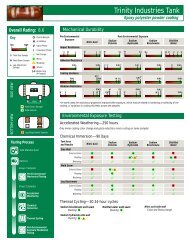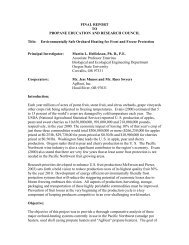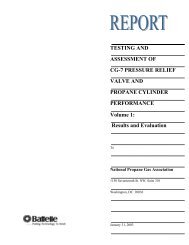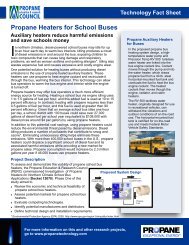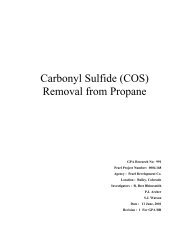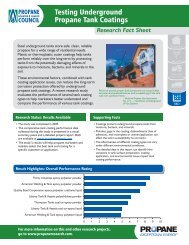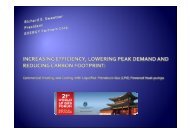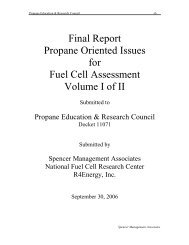Code Approval of Composite Propane Cylinders for Indoor Use ...
Code Approval of Composite Propane Cylinders for Indoor Use ...
Code Approval of Composite Propane Cylinders for Indoor Use ...
You also want an ePaper? Increase the reach of your titles
YUMPU automatically turns print PDFs into web optimized ePapers that Google loves.
ConclusionThe propane industry is supportive <strong>of</strong> developing new products to take advantage <strong>of</strong> thecomposite cylinders’ benefits, including indoor use <strong>of</strong> these cylinders. Even more importantly,the propane industry is committed to the safe use <strong>of</strong> these products through their support <strong>of</strong> thefire test programs to identify potential hazards as well as the development <strong>of</strong> educationalmaterials <strong>for</strong> firefighters and the general public on cabinet heaters and indoor use <strong>of</strong> propane.Through these ef<strong>for</strong>ts, data has been generated that indicate composite cylinder fire testper<strong>for</strong>mance is encouraging <strong>for</strong> indoor use, specifically:• The one-piece cylinders did not rupture during any <strong>of</strong> the fire testing per<strong>for</strong>med;• There was no evidence <strong>of</strong> high velocity jetting <strong>of</strong> propane; cylinders vented at pressureslower than the relief valve setting;• <strong>Composite</strong> cylinders were able to withstand exposure to a high radiant heat flux (300kW) without venting;• A burning cylinder cooled by water hose spray did not rupture or crack• The maximum heat release rates <strong>for</strong> empty cylinders are within reason <strong>for</strong> warehousetype storage.• Proposed code changes to NFPA 58 are adequate to provide <strong>for</strong> safe use indoors.- The 16 pound composite cylinder and connection are uniquely designed <strong>for</strong>connection to cabinet heaters, thereby eliminating the possibility that a largercomposite or metal cylinder can be adapted and connected to the heater,- the heater is limited to 10,000 BTU/Hr, and- use <strong>of</strong> the heater is restricted to one- and two-family structures and commercialproperties.• If proposed changes to the National LP Gas <strong>Code</strong> (NFPA 58) are accepted, properlydesigned propane unvented cabinet heaters, when combined with composite cylinders,may present some safety advantages over other types <strong>of</strong> space heaters already approved<strong>for</strong> indoor use in occupied buildings; e.g. kerosene heaters. This may be especially truewhen issues such carbon accidental or intentional cross fueling is considered; e.g. pouringgasoline into a kerosene space heater. <strong>Propane</strong> is a clean burning non-toxic flammablegas.Although the fire test results are encouraging, concerns about consumer misuse (including lack<strong>of</strong> maintenance), tampering, additional fuel load within a residential structure, and the inability<strong>for</strong> composite cylinders to reseal once breached in a fire still remain. Many <strong>of</strong> these concernshave been addressed through engineered systems identified in this study (CGA 793 valve;braided metallic hose; reduced fuel capacity and heater rating); however work should continue toeducate fire pr<strong>of</strong>essionals and consumers in the safe handling, storage, use, and fire per<strong>for</strong>mance<strong>of</strong> composite cylinders and associated appliances <strong>for</strong> indoor use.<strong>Composite</strong> <strong>Propane</strong> <strong>Cylinders</strong> 43February 2007<strong>for</strong> <strong>Indoor</strong> <strong>Use</strong> — Phase IIBattelle



